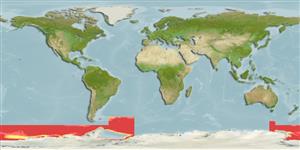Environment: milieu / climate zone / depth range / distribution range
Ecología
marino; rango de profundidad 10 - 1600 m. Polar; 50°S - 78°S, 143°E - 19°W (Ref. 1371)
Southern Ocean: coasts of Antarctic Peninsula, Scotia Sea (South Georgia, South Sandwich, South Orkney and South Shetland islands), Victoria Land and Ross Sea.
Length at first maturity / Tamaño / Peso / Age
Maturity: Lm 27.5, range 23 - 32 cm
Max length : 35.0 cm TL macho / no sexado; (Ref. 1371); common length : 27.0 cm TL macho / no sexado; (Ref. 1371)
Short description
Morfología | Morfometría
Espinas dorsales (total): 0; Radios blandos dorsales (total): 135; Espinas anales 0; Radios blandos anales: 106; Vértebra: 69. Dorsal filament variable in length, but never longer than twice the eye diameter. Outer rays of the pelvic fins filamentous, of unequal lengths. Lateral line arched above the pectoral fin, extending to slightly beyond the pectoral fin tips. Color is uniform gray-brown, with iridescent hues.
Dwells in continental and insular shelves and slopes. Feeds on zooplankton. Synchronous spawner (Ref. 50743).
Cohen, D.M., T. Inada, T. Iwamoto and N. Scialabba, 1990. FAO species catalogue. Vol. 10. Gadiform fishes of the world (Order Gadiformes). An annotated and illustrated catalogue of cods, hakes, grenadiers and other gadiform fishes known to date. FAO Fish. Synop. 125(10). Rome: FAO. 442 p. (Ref. 1371)
IUCN Red List Status (Ref. 130435)
Threat to humans
Harmless
Human uses
Pesquerías: escaso valor comercial
Más información
Age/SizeCrecimientoLength-weightLength-lengthLength-frequenciesMorfometríaMorfologíaLarvaDinámica larvariaReclutamientoAbundanciaBRUVS
ReferenciasAcuiculturaPerfil de acuiculturaRazasGenéticaElectrophoresesheritabilidadEnfermedadesProcesamientoNutrientsMass conversion
Herramientas
Special reports
Download XML
Fuentes de Internet
Estimates based on models
Preferred temperature (Ref.
123201): -1.9 - 1.6, mean -0.7 °C (based on 751 cells).
Phylogenetic diversity index (Ref.
82804): PD
50 = 0.5059 [Uniqueness, from 0.5 = low to 2.0 = high].
Bayesian length-weight: a=0.00437 (0.00168 - 0.01136), b=3.11 (2.89 - 3.33), in cm total length, based on LWR estimates for this (Sub)family-body shape (Ref.
93245).
Nivel trófico (Ref.
69278): 3.4 ±0.4 se; based on diet studies.
Generation time: 4.2 ( na - na) years. Estimated as median ln(3)/K based on 1
growth studies.
Resiliencia (Ref.
120179): Medio, población duplicada en un tiempo mínimo de 1.4-4.4 años (tm=4; Fec = 85,810).
Fishing Vulnerability (Ref.
59153): Moderate vulnerability (41 of 100).
Climate Vulnerability (Ref.
125649): High vulnerability (62 of 100).
Nutrients (Ref.
124155): Calcium = 28.6 [13.1, 61.2] mg/100g; Iron = 0.478 [0.243, 0.999] mg/100g; Protein = 16.8 [15.3, 18.2] %; Omega3 = 0.265 [0.119, 0.570] g/100g; Selenium = 17.6 [5.9, 46.3] μg/100g; VitaminA = 14 [3, 74] μg/100g; Zinc = 0.526 [0.336, 0.834] mg/100g (wet weight);
